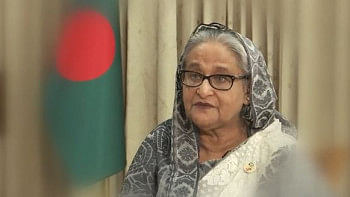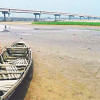The Mirage of Teesta Treaty

Every time the prime ministers of Bangladesh and India visit each other's country, the issue of the Teesta treaty surfaces in public discussions – at least in Bangladesh. The same has happened during Bangladesh Prime Minister Sheikh Hasina's ongoing visit to India.
Bangladesh's foreign minister has now clearly stated that there is no scope for progress on the Teesta treaty during this bilateral summit. However, what is necessary is to go further and make an honest admission that there is no scope for any meaningful Teesta treaty, so far as augmenting the dry season flow of the river into Bangladesh is concerned – neither now, nor in the future – if the country continues its water diplomacy with India within the confines that it has boxed itself into. Such an admission will prevent the people of Bangladesh from raising their expectations during these visits and then feel disappointed when nothing actually materialises. It's necessary for them to understand that the Teesta treaty has now become a mirage, running after which can only lead to frustrations.
There are two reasons why the Teesta water-sharing treaty is now a mirage. The first concerns the centre-state relationship of West Bengal and Delhi. It is nearly impossible for India's central government to sign any meaningful treaty over the stiff objections from the state government of West Bengal. However, the second and more underlying reason is that so much of the Teesta flow is diverted via the Gajoldoba Barrage for irrigation in West Bengal that there is hardly any dry season flow left to be shared with Bangladesh. It's because of the entrenched interests of the irrigators in West Bengal that the state government cannot agree to a greater share of the Teesta for Bangladesh; this, in turn, prevents India from accommodating Bangladesh's demands.
Following the construction of Gajoldoba Barrage, the minimum flow of the Teesta River in Bangladesh has precipitously declined from about 200 cumec (cubic metre per second) to below 40 cumec. Furthermore, the Indian authorities are planning to build about 15 more diversionary and impounding structures on the upstream reaches of the Teesta and its tributaries. The river's flow at the Gajoldoba point will, therefore, surely decrease in the future, shrinking further the possibility of dry season flow augmentation in Bangladesh.


This mirage of water-sharing treaties with India applies to the Ganges River too. The 30-year treaty, signed in 1996, is often presented as a success. Unfortunately, while the pre-Farakka dry-season volume of the Ganges flow in Bangladesh was more than 2,000 cumec, it decreased to less than 500 cumec after the Farakka Barrage went into operation, and this volume basically remained unchanged after the 1996 treaty. Moreover, the absence of any guarantee clause in this treaty makes Bangladesh's situation more precarious, because India can now let the Ganges flow into Bangladesh to fall below the minimum environmental flow.
The additional problem that Bangladesh is now facing is that the Indian barrages have now become an additional source of severe fluctuations in the river flow, causing horrendous floods at unexpected times of the year. This has been particularly the case with the Teesta Basin, where such sudden onrush of water, let out by Gajoldoba operators by opening all the vents of the barrage, are causing immense miseries to the people of the basin, destroying their crops and washing away their household assets. There were several such episodes this year alone.
The drastic reduction of the dry season flow, followed by high volumes in the wet season, is destabilising Bangladesh's rivers, causing harmful changes in their morphology. In the dry season, the river beds desiccate and harden, reducing the bed scouring that previously took place in the wet season. To accommodate the high volumes of the wet season, the rivers therefore erode their banks, with devastating effects on the lives and properties of the people living in the river basins. Consequently, Bangladesh's rivers are becoming shallower and wider.
It's not clear whether the representatives of Bangladesh are conveying properly to their Indian counterparts the multidimensional harmful impacts of India's dams and barrages on Bangladesh. The young ministers who recently returned from attending the Joint River Commission (JRC) meeting held in Delhi after a long hiatus of 12 years couldn't quite reassure the nation that they raised and pressed the right and important issues at this meeting.
It is, therefore, necessary to be aware of the real and unvarnished truth regarding the sharing of common rivers. Once this awareness sinks in, it can prompt Bangladesh to stop running after mirages and instead think about real alternatives that can be pursued to establish the country's rightful claims on the shared rivers.
The first step should be signing the 1997 United Nations Convention on the Law of Non-Navigational Uses of International Watercourses, which upholds many legitimate rights of lower riparian countries. It's true that India wants the negotiations regarding shared rivers to be confined to the bilateral framework. However, signing this convention will allow Bangladesh to refer to and seek backing from this convention even in its bilateral negotiations with India. Bangladesh may urge India and other countries in South Asia to sign this convention, so that all the countries can refer to a common and internationally agreed code of conduct regarding international rivers. Signing this convention can also make it easier for Bangladesh to use any international opportunity that may arise to promote its cause regarding the shared rivers.

Second, Bangladesh can link the river-sharing issue with the issue of transit, transshipment, port, and other facilities that it has already granted and plans to grant to India to help it accelerate the development of its seven northeastern states. Both India's advantage as the upper riparian country and Bangladesh's advantage as being able to provide India a shorter and more convenient route to reach the Seven Sisters arise from the same historical fact, namely the Radcliffe border. Hence, it makes sense for Bangladesh to propose that the two countries should trade the respective advantages that this border conferred to them. Thus, Bangladesh can ask India to restore the full natural flows of the rivers in exchange for granting India the transit, transshipment, port, and other related facilities.
Third, Bangladesh can add its voice to the growing demand inside India for the demolition of the Farakka Barrage. About 50 years of experience has vindicated Kapil Bhattacharya, the chief engineer of West Bengal who had opposed the construction of Farakka and predicted that it would not be able to flush sediment from the Hooghly River and instead would cause flood and erosion in Murshidabad and Bihar. The time has come to undo the damage that Farakka has done to both India and Bangladesh.
Finally, sustainable and wide-ranging cooperation between Bangladesh and India requires the goodwill of the people of the two countries to each other. It cannot be denied that the restoration of full natural flows of the rivers would go a long way in strengthening the goodwill between the two nations. It is, therefore, in India's interest to rethink its river policies towards Bangladesh. Instead of ruthless maximisation of the upper riparian advantage, it should adopt a more enlightened view. Instead of mirages, it should propose real solutions.
Dr S Nazrul Islam is the founder of Bangladesh Environment Network (BEN) and the initiator of Bangladesh Poribesh Andolon (BAPA). He is the author of Water Development in Bangladesh: Past, Present and Future.

 For all latest news, follow The Daily Star's Google News channel.
For all latest news, follow The Daily Star's Google News channel. 









Comments